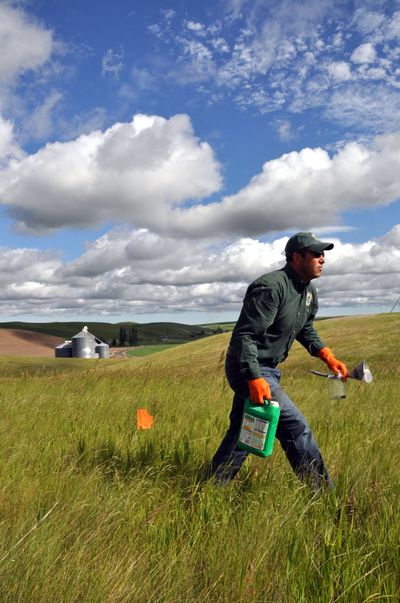Research aims to fine-tune vast CRP lands to boost pheasants

Joey McCanna is working to make CRP more friendly to pheasants.
In particular, the Washington Fish and Wildlife Department upland game bird specialist is seeking ways to make the vast acreage enrolled in the Conservation Reserve Program more beneficial to pheasant chicks and other birds.
“If we can get more chicks to survive their first few critical weeks of life, it could make a big difference in overall population,” he said.
His research on CRP plots, a four-year study geared up this year in Whitman County, springs from previous studies. In particular, he’s taking off from research showing that bugs, an important source of protein, comprise about 90 percent of a game-bird chick’s diet for the first two weeks of life.
These invertebrates continue to be the primary dietary component for the first 8 weeks of development before pheasant chicks transition to the adult diet that involves more grains and broad-leaf plants.
Studies have shown that some CRP lands are richer in bugs than others.
McCanna is trying to fine-tune the recipe.
Federal Farm Bill conservation programs pay farmers to idle their land for a variety of reasons, ranging from reducing soil erosion to improving air and water quality.
Washington has about 1.45 million acres enrolled in CRP.
Wildlife stands to benefit enormously if these programs are tweaked in the favor of critters. For example, instead of planting crested wheatgrass that’s of little food value to wildlife, it might cost no more to plant a mix of forbs and grasses that provides cover and food for pheasants.
Whitman County producers, who have 193,077 acres enrolled in CRP, were paid roughly $156 million for idling land from 1995-2010. Pheasants and other wildlife likely would reap more benefits if the seeds sowed into CRP were tailored to their survival.
South Dakota, a national model for boosting wildlife with CRP and other farm programs, documented that pheasant populations increased from 3 million to 10 million after 1.8 million acres of cropland were converted to a grass and legume cover about four decades ago.
More recent studies show that forbs and legumes appear to be more important when establishing CRP in a sea of wheat such as western Kansas compared to South Dakota which has a more diverse land use.
Portions of Whitman County fit both models
Waves of grain often are adjacent to expanses of CRP grasses that are left uncut for years.
McCanna enlisted the help of several farmers to plant five-acre plots with different seed mixes.
Some were planted with native forbs and legumes while others were planted with non-native forbs and legumes.
From spring through mid-July, as the pheasants worked to hatch their 2011 crop of chicks, McCanna and helpers went out each week to sample the bug populations in these plots and untouched control plots.
They set specially designed pitfall traps that captured and preserved bugs and larvae, which were take to Washington State University labs to be counted and sorted by species.
They also walked through the test plots sweeping nets to sample bugs that go airborne in front of them.
To the uneducated observer, the traps reveal the fields are crawling with bugs. A trap that might attract and kill a field mouse will be full of carrion beetles in a few days.
“Look at this,” he said pulling one of the traps from a test plot and poking through numerous bugs ranging from itsy bitsy to longer than an inch. “This is a buffet for pheasant chicks.”
While WSU scientists are still crunching the numbers of bugs, McCanna could generally see some trends in his field work.
“Pheasants like weeds, we know that,” he said. “Farmers don’t like weeds. We know that, too.
“So we’re working through the alternatives.”
When weeds have infested CRP planted with the original planting mix, landowners were allowed to spray entire fields with herbicide. That killed the majority of broad-leaved forbs and legumes left the land in grasses that housed fewer invertebrates and therefore fewer pheasant chicks.
Plots featuring a mix of native plants establish slower and are more expensive to plant, but they last longer, he said.
Plots of nonnative plants are cheaper and establish faster, but they don’t last as long.
Research has found that CRP plots lose their vigor for supporting invertebrates – and pheasant chicks – after about seven years while most CRP contracts are for at least 10 years.
“That suggests there would be benefits to mid-contract forb plantings in existing CRP,” he said.
“Right now, suggesting native forbs and legumes to landowners is a tough sell. So I’m working to boil down the pros and cons of alternatives for improving existing CRP lands. If it turns out that native legumes and forbs are the best for pheasants, at least we’ll have that information to give landowners – and the data to back it up.”
Wildlife biologists are trying to work with new rules so that invigorating CRP can be written into the conservation plans in the contracts.
About 455,000 acres of CRP in Eastern Washington pheasant country has transitioned to being grass-dominated, he said, noting that offers a lot of potential for boosting pheasants.
“The goal is to diversify and manage CRP so we get the most bang for the buck,” McCanna said.